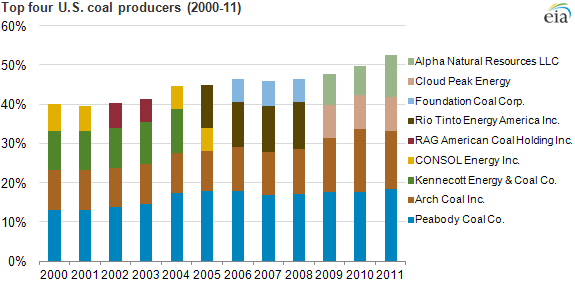
Top four U.S. coal companies supplied more than half of U.S. coal production in 2011

Note: *2012 data are preliminary.
Republished October 23, 2013 to correct an error in the text.
In the past two years, more than half of U.S. coal production was attributable to the top four coal producers, the result of changes in regional production as well as decades-long trends towards the concentration of coal production around the top few companies. Peabody Energy Corporation, Arch Coal Inc., Alpha Natural Resources LLC, and Cloud Peak Energy together supplied 575 million tons, or 52% of total U.S. coal production, in 2011, while more than 500 other companies supplied the remaining 48%. By comparison, the fifth largest coal producer in 2011, Consol Energy Company, contributed 34 million tons less than fourth-place Cloud Peak Energy, which produced 96 million tons.

Note: *2012 data are preliminary.
Although the four companies that comprise the top four have changed from year to year (see graph of top four coal producers below), the rising share of production held by the top four producers continues a longer term trend that began in the 1990s with the continued expansion of mines in the Powder River Basin in the western United States and with the divestment of coal properties by oil and gas companies. In 1990 and 1995, the top four accounted for 22% and 35%, respectively. By 2002, when total coal production levels were nearly identical to production in 2011, the top four coal producers accounted for 40% of the total U.S. production and increased to over 50% in 2011 and 2012, based on preliminary 2012 data.

In 2011, the coal production from the top four companies combined represented 27% of Appalachian production, 18% of interior production, and 77% of western production.
If measuring by the heat content of the coal produced, the top four coal producers' share of production was about 49% (compared to the 52% share on a tonnage basis) in 2011 because of the lower heat content—measured in British thermal units (Btu)—of western coal sources. Even so, the top four producers on a Btu basis still include Peabody, Arch, Alpha, and Cloud Peak. These companies also maintain a high share of national production because of the decline in higher-Btu Appalachian coal's share of production; in 2011, its share of total production (measured in tons) was 31%, compared to 39% in 2000.

Peabody has been the number one U.S. coal producer for decades. It owns mines in both the western and midwestern basins as well as outside the United States. It expanded its production at existing mines by 56%, or 62 million tons, between 2000 and 2011. Although most of this growth comes from the large, highly productive surface mines of the Powder River Basin, Peabody also owns mines in Arizona, New Mexico, Colorado, and states in the interior region.
Several key mergers and acquisitions in the coal industry have occurred during the past few years. In 2009, Foundation Coal Holdings (fourth-largest producer in 2008) merged with Alpha Natural Resources. This action leapfrogged Alpha Natural Resources from the 14th-largest producer to the fourth-largest but with 16% more production in that slot than its predecessor, Foundation Coal. Alpha Natural Resources then acquired Alpha Appalachia Holdings Company in 2011 (formerly A.T. Massey Coal Company), and its production rose by 35 million tons, or 44%, year-over-year. Alpha Natural Resources owns the Eagle Butte and Belle Ayre mines in Wyoming in addition to Appalachian mines.
In 2009, Rio Tinto Energy of America (RTEA)—the second-largest producer in 2008—reshuffled some production by divesting itself of Jacobs Ranch mine in Wyoming, selling it to Arch Coal. This move allowed Arch Coal, an eastern and western coal producer, to solidify its second-place position in 2009, although it had been in the top four since 1998 when the (then) newly established company first acquired Powder River Basin mines. Cloud Peak Energy—exclusively a Powder River Basin coal company—also spun off from RTEA in 2009 and entered the top four, where it has remained.
Principal contributor: Diane Kearney
Tags: coal, mining, production/supply